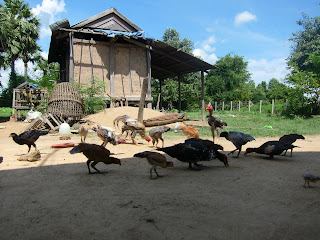 I really misgauged rainy season here.
I really misgauged rainy season here.
Poor assumption #1: In India, the monsoons run from early summer through August, and meterologist I am (not)... I assumed the same would be true for Cambodia. Silly, silly me. Once I arrived, I started hearing about how rainy season was just beginning. And how it lasts through September, no wait, through October, well actually it went into November last year... I'm still pretty unclear on how long the rains will last, but they have begun. It usually rains every day, and this can start mean a light drizzle, a solid rainfall, or a downright white-out pour. Luckily for me, I love it when it rains. I've noticed that listening to raindrops on a roof and watching the earth become washed is one of the most comforting things to me. I got this feeling the first time I was experienced the monsoon in Delhi, and now I get the same feeling everytime. I think it stems from the fact that with eyes closed, rain, the sounds and smell, is the same everywhere in the world. So when it rains I could be at my parents' house in Minnesota, or up at Lake Superior, or in a field station in Nigeria and my sensory memory triggers the same way... and I weirdly feel like I'm at home. Wherever that is.
Poor assumption #2: In both India and Nigeria, when the rains came, no one went outside. It was accepted that if the heavens opened, you would stay in your home/office/shop until it subsided. How long depended on the length of the pour; it could mean 15 minutes or a whole day. And because the rains would flood the streets and make travel nearly impossible, sometimes trips to the field would have to be rescheduled for another day. Again, I assumed Cambodia would also follow this unspoken rule and that I would never really be exposed to rain that much. People have often asked me if I take rainboots with me to monsoon-prone places, and I never have because I don't really venture out into deep puddles. So this time, I also didn't bring a raincoat or umbrella (this is also because I needed to make room for Skittles and extra gummy snacks, which I deemed more useful/necessary than rain gear). Silly, silly me. Cambodians' motto: Rain? Rain, shmain! When the showers begin here, most people really only seek shelter if it's raining so hard you can't see the road in front of you. And because I tend to walk/cycle everywhere, I am often caught in the rain while in transit. Knowing that weather isn't really a valid excuse for tardiness, I have been pedaling/strolling to arrive at my destination, soaked but on time. After lamenting my poor choice of candy over an umbrella, I decided to follow the local custom here and pick up my new best friend: my poncho. Everyone here has one. They cost about 25 cents, come in almost every shade of the rainbow, and have the consistency of an extremely thin garbage bag. When drops start to fall, everyone pulls theirs out, crawls in and carries on. The roads begin to look like a watery Monet of easter eggs, with motorcyclists blearing by in lilac and baby pink, bicyclists in sunny yellow and lemongrassy green, and me in my own sky blue version, all puffed up with air gusts. Which color egg would you be?
















